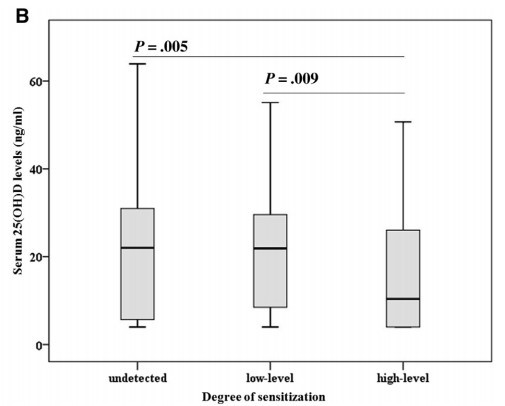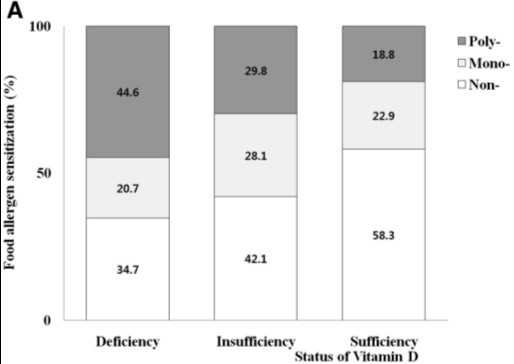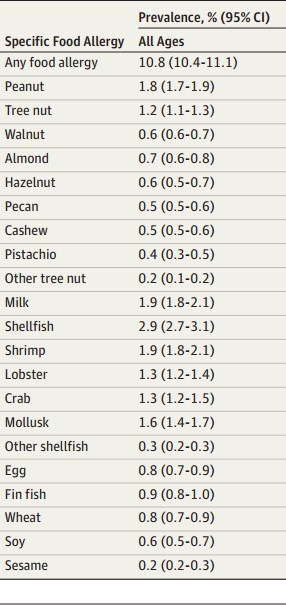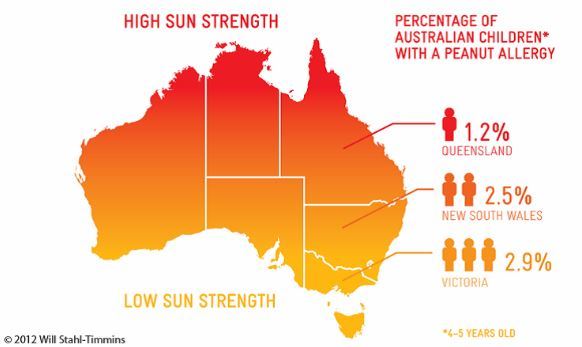Allergy - Overview
See Vitamin D Life
Allergies and Vitamin D
Childhood allergy, asthma and eczema associated with repeated low vitamin D tests – Oct 2016
Five times less mite allergy when vitamin D added in mid pregnancy and to infant – RCT April 2016
Mycotoxins from mold can massively effect human health and decrease Vitamin D in 4 ways Research concludes vitamin D may treat or prevent allergy to common mold
Immune System response of infants is associated with higher levels of vitamin D – RCT Nov 2014
Increase in vitamin D deficiency may partially explain increases in asthma and allergies – Jan 2015
Allergies and low vitamin D strongly associated with night shift bakers– Sept 2014
Vitamin D, Vitamin A, or Vitamin E association with allergies and asthma – Feb 2012
Hypothesis: Allergic diseases have increased because of decreased vitamin D – Oct 2014
Less sun (less vitamin D) more anaphylaxis (severe allergic reaction) – June 2014
2X more allergies if 11th womb week was in Spring – Vitamin D or pollen Oct 2010
Is Vitamin D Supplementation Responsible for the Allergy Pandemic – May 2012
Search Vitamin D Life for ALLERGY (CAT OR DOG OR PET OR DANDER) 240 items as of March 2018
Food Allergy
Food allergy is linked to season of birth, sun exposure, and vitamin D deficiency – Jan 2019
Food allergies and low vitamin D – thymus may be the connection – June 2016
30 to 40 ng of vitamin D associated with the least peanut allergy – Nov 2012
Food allergy 12X more likely if low vitamin D and vitamin D binding gene problem – Aug 2015
- Hypothesis: Low vitamin D as a fetus then lots of vitamin D as an infant confuses the body
Less sun (less vitamin D) more anaphylaxis (severe allergic reaction) – June 2014
3X more allergy to peanuts if child born with low UV – Feb 2011
Items in both categories Autoimmune and Infant/Child are listed here:
{category}
Might peanut allergy be associated with low vitamin D? asked Perplexity AI July 2024
There is evidence suggesting a potential association between peanut allergy and low vitamin D levels. Several studies have explored this relationship, indicating that vitamin D deficiency might play a role in the development of food allergies, including peanut allergy.
Evidence Supporting the Association
- Australian Study :
- An Australian study found that infants with low vitamin D levels were more likely to have egg or peanut allergies and multiple allergies compared to those with normal vitamin D levels. This suggests that vitamin D might have a protective role against the development of food allergies.
- Role of Vitamin D in Immune Function :
- Vitamin D is known to play a crucial role in the immune system. It helps modulate both the innate and adaptive immune responses, which are essential in preventing allergic reactions. Deficiency in vitamin D has been associated with increased autoimmunity and susceptibility to infections, which could indirectly contribute to the development of allergies.
- Geographical and Seasonal Variations :
- Research has shown that areas with lower ambient ultraviolet radiation (UVR), which results in lower vitamin D synthesis, have higher rates of childhood food allergies, including peanut allergy. Additionally, being born in seasons with less UVR exposure (autumn or winter) has been linked to a higher risk of food allergies and anaphylaxis.
- Direct Measures of Vitamin D :
- Studies using direct measures of vitamin D from blood samples have shown an association between low vitamin D levels and increased risk of allergic sensitization in children and adolescents, as well as food allergies in infants.
Specific Study on Peanut Allergy :
- A study by Mullins et al. found that higher neonatal 25(OH)D levels were associated with a reduced risk of peanut allergy in children. Specifically, levels of 75 to 99.9 nmol/L were linked to a reduced risk, while levels lower than 50 nmol/L did not show a significant difference from the reference group.
Contradictory Findings
While there is substantial evidence supporting the association between low vitamin D and increased risk of food allergies, including peanut allergy, some studies have presented contradictory findings. For example, some research suggests that higher vitamin D levels might increase the likelihood of allergic sensitization and food allergies. This indicates the need for further well-designed randomized controlled trials to clarify the relationship.
Conclusion
Overall, the current body of research suggests that there might be an association between low vitamin D levels and an increased risk of peanut allergy. However, the relationship is complex and not entirely understood, with some studies showing contradictory results. Ensuring adequate vitamin D levels through sensible sun exposure and dietary intake might be beneficial, but more research is needed to establish definitive guidelines and understand the underlying mechanisms
Perplexty references, images, videos
7 of many studies about egg or peanut allergy and Vitamin D - July 2024
Association of food allergy in children with vitamin D insufficiency: a systematic review and meta-analysis - Feb 2023 https://doi.org/10.1007/s00431-023-04843-2 YES
A narrative review of vitamin D and food allergy in infants and children - Oct. 2021 [doi: 10.21037/tp-21-396|FREE PDF]
- " A lot of laboratory studies have confirmed that vitamin D is involved in the immune regulation of food allergy. Evidence indicates there may be a nonlinear relationship between vitamin D and food allergy. Further researches need to be launched."
Maternal Vitamin D Levels during Late Pregnancy and Risk of Allergic Diseases and Sensitization during the First Year of Life—A Birth Cohort Study - Aug 2020 FREE PDF
"A total of 43.2% pregnant women were Vitamin D deficient (<30 nmol/L) and 56.8% were nondeficient (≥30 nmol/L). A total of 27.6% of the infants had eczema, 6.1% had wheeze, 27.4% had food sensitization, 10.8% had inhalant allergen sensitization, and 3.8% had IgE-mediated food allergy during the first year of life. Compared with the nondeficient group, maternal Vitamin D deficiency in late pregnancy was not associated with any allergic outcomes after adjustment for potential confounding factors. In conclusion, the present study does not support an association between maternal Vitamin D levels in late pregnancy and allergic outcomes during the first year of life."
Two errors: 1) considered low vitamin D to be < 30 nmol. 2) only considered 3rd quartile
Is antenatal or early-life vitamin D associated with eczema or food allergy in childhood? A systematic review Jan 2023 https://doi.org/10.1111/cea.14281 YES
Food allergy in children is associated with Vitamin D deficiency: A case‐control study. - 2022 10.1111/apa.16206 NO
In “High-Risk” Infants with Sufficient Vitamin D Status at Birth, Infant Vitamin D Supplementation Had No Effect on Allergy Outcomes: A Randomized Controlled Trial -
400 IU daily produced virtually no change in vitamin D levels from infants not getting any Vitamin D - June 2020 FREE PDF
No change in allergies (no surprise)
Vitamin D and Omega-3 (Fatty Acid) Supplementation in Pregnancy for the Primary Prevention of Food Allergy in Children-Literature Review - Feb 2023 FREE PDF
- Looks like Omega-3 during pregnancy should reduce food allergies
Food Allery episode 4X more likely if low vitamin D, etc. - meta-analysis April 2023
Association of food allergy in children with vitamin D insufficiency: a systematic review and meta-analysis
European J.l of Pediatrics, Vol 182, pages 1533–1554, (2023) https://doi.org/10.1007/s00431-023-04843-2
PDF is behind paywall, but references are free
Evdokia Psaroulaki, Georgios N. Katsaras, Petrina Samartzi, Vasiliki Chatziravdeli, Danai Psaroulaki, Evangelos Oikonomou & Pelagia Tsitsani
Current literature regarding the association of vitamin D insufficiency and food allergy is contradicting. The purpose of our study was to investigate this association. This is a systematic review and meta-analysis according to the PRISMA statement. PubMeD and Scopus databases were systematically searched for case–control studies investigating the association between pediatric food allergy and vitamin D insufficiency. Our search yielded 806 studies. Ten final studies were considered eligible for qualitative and quantitative analysis.
Children with vitamin D insufficiency were found to have 68% more probability to present a food allergy episode (adjusted pooled OR: 1.68, 95% CI [1.25–2.27], p-value: 0.001).
In their second year of life they were 4 times more likely to present a food allergy episode (adjusted pooled OR: 4.06 , 95% CI [1.93–8.56], p-value: < 0.001), and 56% more probable to develop food sensitization (OR: 1.56, 95% CI [1.15–2.11], p-value: < 0.004).
Children in Australia with vitamin D insufficiency were almost 4 times more likely to develop egg sensitization (adjusted OR: 3.79, 95% CI [1.19–12.08], p-value: 0.024).
Children with vitamin D insufficiency were almost twice as likely to have peanut sensitization (OR: 1.96, 95% CI [1.08–3.57], p-value: 0.028).
Conclusion: Decreased maternal vitamin D levels and infant vitamin D insufficiency appear to increase the incidence of food allergies, particularly in the second year of life. To confirm this association, multicenter longitudinal studies are required.
Food allergies 2X to 4X more likely if vitamin D < 30 ng - meta-analysis Feb 2023
Association of food allergy in children with vitamin D insufficiency: a systematic review and meta-analysis
European Journal of Pediatrics, Vol 182, pages 1533–1554, (2023) https://doi.org/10.1007/s00431-023-04843-2 PDF behind paywall
Evdokia Psaroulaki, Georgios N. Katsaras, Petrina Samartzi, Vasiliki Chatziravdeli, Danai Psaroulaki, Evangelos Oikonomou & Pelagia Tsitsani
Current literature regarding the association of vitamin D insufficiency and food allergy is contradicting. The purpose of our study was to investigate this association. This is a systematic review and meta-analysis according to the PRISMA statement. PubMeD and Scopus databases were systematically searched for case–control studies investigating the association between pediatric food allergy and vitamin D insufficiency. Our search yielded 806 studies. Ten final studies were considered eligible for qualitative and quantitative analysis.
Children with vitamin D insufficiency were found to have 68% more probability to present a food allergy episode (adjusted pooled OR: 1.68 , 95% CI [1.25–2.27], p-value: 0.001).
In their second year of life
they were 4 times more likely to present a food allergy episode (adjusted pooled OR: 4.06 , 95% CI [1.93–8.56], p-value: < 0.001), and
56% more probable to develop food sensitization (OR: 1.56 , 95% CI [1.15–2.11], p-value: < 0.004).
Children in Australia with vitamin D insufficiency were almost 4 times more likely to develop egg sensitization (adjusted OR: 3.79 , 95% CI [1.19–12.08], p-value: 0.024).
Children with vitamin D insufficiency were almost twice as likely to have peanut sensitization (OR: 1.96 , 95% CI [1.08–3.57], p-value: 0.028).
Conclusion: Decreased maternal vitamin D levels and infant vitamin D insufficiency appear to increase the incidence of food allergies, particularly in the second year of life. To confirm this association, multicenter longitudinal studies are required.
PDF is at DeepDyve
Food Allergy 5X more likely if low vitamin D – Oct 2014
The link between serum vitamin D level, sensitization to food allergens, and the severity of atopic dermatitis in infancy.
J Pediatr. 2014 Oct;165(4):849-54.e1. doi: 10.1016/j.jpeds.2014.06.058. Epub 2014 Aug 6.
Baek JH1, Shin YH1, Chung IH1, Kim HJ1, Yoo EG1, Yoon JW2, Jee HM1, Chang YE3, Han MY4.
1Department of Pediatrics, CHA University School of Medicine, Seongnam, Korea.
2Myongji General Hospital, Goyang, Korea.
3Department of Food and Nutrition Services, CHA Bundang Medical Center, Seongnam, Korea.
4Department of Pediatrics, CHA University School of Medicine, Seongnam, Korea. Electronic address: [email protected].
OBJECTIVE: To investigate the association between serum vitamin D levels, sensitization to food allergens, and the severity of atopic dermatitis in infants.
STUDY DESIGN: We investigated serum 25-hydroxyvitamin D (25[OH]D) and specific immunoglobulin E levels to common or suspected food allergens in 226 infants with atopic dermatitis or food allergy. The severity of atopic dermatitis by the Scoring Atopic Dermatitis index and amount of vitamin D intake was measured in subcohort children. Sensitization to food allergens was categorized by the number (non-, mono-, and poly-) of sensitized allergens and the degree (undetected-, low-, and high-level) of sensitization.
RESULTS: Significant differences in 25(OH)D levels were found between groups on number (P = .006) and degree (P = .005) of food sensitization. The polysensitization group had significantly lower levels of 25(OH)D than the nonsensitization (P = .001) and monosensitization (P = .023) group. High-level sensitization group had significantly lower 25(OH)D levels compared with undetected (P = .005) and low-level (P = .009) sensitization group. Vitamin D deficiency increased the risk of
sensitization to food allergens (OR 5.0; 95% CI 1.8-14.1), especially to
milk (OR 10.4; 95% CI 3.3-32.7) and
wheat (OR 4.2; 95% CI 1.1-15.8).
In addition, the9% of US adults believe they have a food allergy Scoring Atopic Dermatitis index was independently related to 25(OH)D levels after adjusting for the level of sensitization (adjusted R(2) = 0.112, P = .031).
CONCLUSIONS: Our results suggest that vitamin D deficiency increases the risk of sensitization to food allergens and that atopic dermatitis may be more severe in infants with vitamin D deficiency.


📄 Download the PDF from Vitamin D Life.
19% of US adults now believe that they have a food allergy - 2019
Prevalence and Severity of Food Allergies Among US Adults - JAMA
📄 Download the PDF from Vitamin D Life

Seems that they do not consider gluten intolerance to be a food allergy
10X more likely to have multiple food allergies if low vitamin D - Sept 2013
1 page item had the following results

Food allergies are associated with both Vitamin D and Vitamin D genes - 2018
Cellular and molecular mechanisms of vitamin D in food allergy
Journal of cellular and molecular medicine, DOI:10.1111/jcmm.13607
Ashlyn Poole, Yong Song, +2 authors Guicheng Brad Zhang
Food allergies are becoming increasingly prevalent, especially in young children. Epidemiological evidence from the past decade suggests a role of vitamin D in food allergy pathogenesis. Links have been made between variations in sunlight exposure, latitude, birth season and vitamin D status with food allergy risk. Despite the heightened interest in vitamin D in food allergies, it remains unclear by which exact mechanism(s) it acts. An understanding of the roles vitamin D plays within the immune system at the cellular and genetic levels, as well as the interplay between the microbiome and vitamin D, will provide insight into the importance of the vitamin in food allergies. Here, we discuss the effect of vitamin D on immune cell maturation, differentiation and function; microbiome; genetic and epigenetic regulation (eg DNA methylation); and how these processes are implicated in food allergies.
📄 Download the PDF from Vitamin D Life
RTI 36% more likely if low Vitamin D during pregnancy - meta-analysis - May 2018
Prenatal vitamin D status and respiratory and allergic outcomes in childhood: A meta-analysis of observational studies.

Pediatric allergy and immunology, DOI:10.1111/pai.12876
not on sci-hub as of Jan 2019 but can be read in DeepDive
Rosa M Pacheco-González, L Garcia-Marcos, Eva Morales
BACKGROUND: Prenatal vitamin D status may influence offspring's respiratory and allergic outcomes; however, evidence is inconclusive. A systematic review and meta-analysis were conducted on the association between 25-hydroxyvitamin D [25(OH)D] levels in maternal blood in pregnancy or cord blood at birth with the risk of offspring's respiratory and allergic conditions.
METHODS: Two independent researchers conducted systematic searches for observational studies published until May 2017 using defined keywords on vitamin D and health outcomes, including respiratory tract infections (RTIs), wheeze, asthma, atopic eczema, allergic rhinitis, allergic sensitization, and lung function. Random-effects meta-analyses were conducted.
RESULTS: A total of 34 from 547 retrieved articles were included. Increased prenatal exposure to 25(OH)D was inversely associated with risk of RTIs. Comparing the highest with the lowest category of 25(OH)D levels, the pooled odds ratio was 0.64 (95% CI 0.47, 0.87). A positive borderline association was found for lung function at school age (FEV1 z-score coefficient 0.07, 95% CI -0.01, 0.15). No associations were found for wheeze, asthma, atopic eczema, allergic rhinitis, and allergic sensitization.
CONCLUSION: The introduction of public health measures to tackle vitamin D status in pregnancy may reduce the burden of RTIs in offspring. Current evidence does not support an impact on asthma and allergy.
Allergy Symptoms: much more than sneezing, runny eyes (nothing about Vitamin D) - May 2025
A sore throat, Clogged ears, Nose bleeds, Snorting, grunting, and other strange noses, Exhaustion
Undereye circles, A nasal crease, Itching, tingling, or mild swelling in your mouth, Bad breath, Rashes
10 Weird Symptoms That Might Be Allergies Time Magazine May 2025
See also web
Vitamin D3 and Allergies from VitaminD3Blog March 2011
- Mentions several articles and has video of Dr. Daniel A. Searing: Vitamin D Deficiency Linked to Allergies, Asthma in Children
5 Ways Americans' Allergies Are Getting Worse Heartland Time Magazine May 2011 - based on Qwest study
Overall allergy rates up 6% in 4 years
ragweed up 15%
Study: Living With Pets May Protect Infants From Allergies Heartland Time June 2011
Perhaps kids with pets are outdoors more, and thus have higher levels of vitamin d
Additional possibility: cat fur (like most animal fur and feathers) has vitamin D - probably some will rub off when petting
- Risk of food sensitivity increased by 2X if consistently low vitamin D levels
- Allergy in Children in Hand Versus Machine Dishwashing Pediatrics Feb 2015 (nothing about vitamin D)
- 2X less likely to have food allergy if dishes were washed by hand, not machine
- lower likelihood of eczema (23% vs. 38%) and not other allergy-related symptoms like asthma,
- this adds to the “hygiene hypothesis,” which includes having pets, eating fish and living on a farm
- researchers note that overcrowded housing, low socioeconomic status and immigration status can also be linked to fewer allergies
World Allergy Organization decided that ZERO vitamin D should be given during pregnancy or to infants or children - 2016
Food allergy 2.2X MORE likely if high vitamin D - 2016 disagrees with all previous studies
- 📄 Download the PDF from Vitamin D Life
- Seasonal Allergies in Austin, Texas - nothing about Vitamin D

- 📄 Download the PDF from Vitamin D Life
Why the World Is Becoming More Allergic to Food BBC Sept 2020
"Food allergy now affects about 7% of children in the UK and 9% of those in Australia, for example. "
"For example, there was a five-fold increase in peanut allergies in the UK between 1995 and 2016."
"Migrants appear to show a higher prevalence of asthma and food allergy in their adopted country"
- Note: Migrants tend to have darker skins and are going to countries far from Equator
Vitamin D deficiency is mentioned as a strong possibility
One of their references is on Vitamin D Life
106+ Vitamin D Life pages with ALLERG in title
This list is automatically updated
{LIST()}

